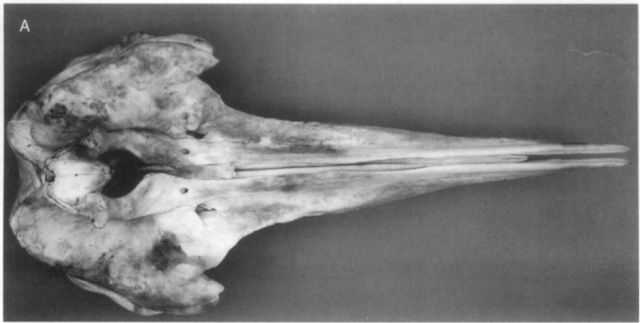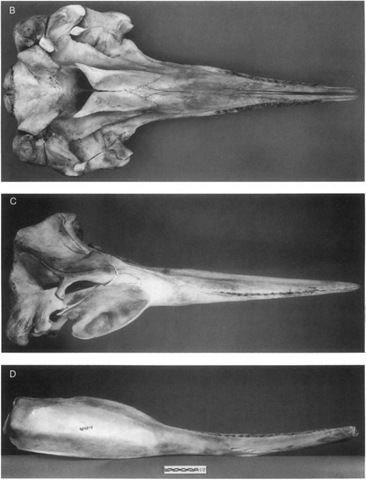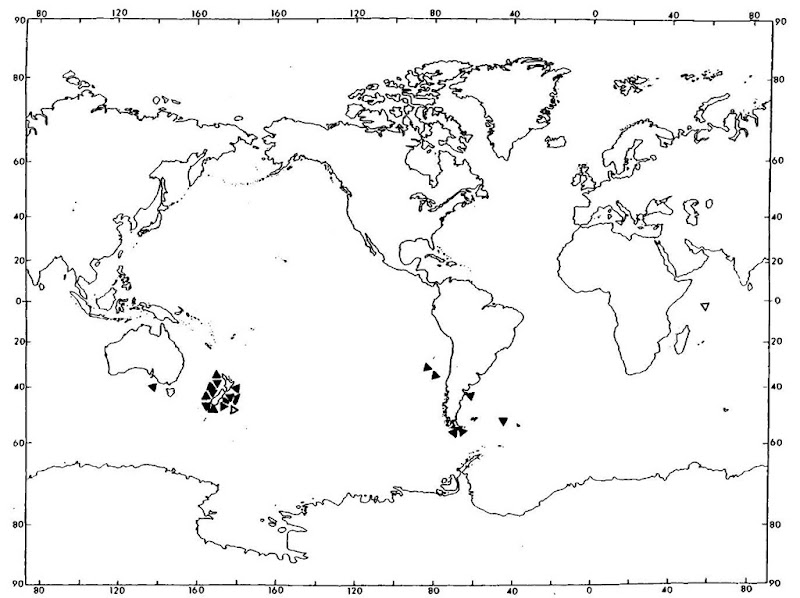Shepherd’s beaked whale is a rare animal, being known only from 21 strandings in the Southern Hemisphere. It is unusual in that it is the only beaked whale with a full set of functional teeth in both jaws.
I. Diagnostic Characters
Shepherd’s beaked whale (Tasmacetus shepherdi, Oliver, 1937) is the only beaked whale to have a full set of functional teeth (Fig. 1). It has between 17 and 21 upper teeth on each side and between 18 and 28 lower teeth. The first tooth in the mandible is enlarged, and it is thought that size difference makes it homologous to the single teeth of other beaked whales. It was initially thought to be a primitive member of the beaked whale family (Ziphiidae) on the basis of retention of teeth. There has not been a good study of the evolutionary relationships of the beaked whales, but Tasmacetus seems in ways other than the teeth to be just as specialized as the remainder of the family. Adults are between 6 and 7 m in length. The only known calf was 340 cm long. This calf had plastic debris in its stomach, but it is not known whether it had begun to take normal solid food. The pigmentation pattern (Fig. 2) is dark gray dorsally, with a white field ventrally extending dorsally on both the anterior and posterior sides of the flipper. The dark dorsal field extends onto the flipper. Another extension of the white ventral field lies dorsal to the anus.
II. Distribution
The geographic records of Tasmacetus are illustrated in Fig. 3. It is known from strandings in New Zealand (12), Australia (1), Argentina (3). Juan Fernandez Islands (2), and the south Sandwich Islands. There are two published sightings attributed to this species: one from New Zealand and one from the Seychelles Islands. It is limited to temperate waters and may not ordinarily come as far north as the tip of Africa.
Figure 1 (A) Dorsal view of skull, (B) ventral view of skull, (C) right lateral view of skull, and (D) right lateral view of mandible of a Tasmacetus shepherdi 660-cm female. All figures are shot at the same scale: 10-cm scale bar is in D.
Figure 2 External view of an adult female T. shepherdi
III. Ecology (Habitat, Prey, and Predators)
This species presumably feeds primarily on squid and fish. One stranded adult female had traces of bottom fish, squid, and one small crab. All of the beaked whales that are moderately well known feed offshore in deep water.
IV. Interactions with Humans
Shepherd s beaked whale has not been known to be involved in any fisheries and certainly has not been kept in captivity. It was first known to science by a publication on a stranded adult female, which Shepherd found and collected in 1933.
Figure 3 Geographic records of T. shepherdi. Closed triangles represent strandings, and open triangles represent published sightings that are attributed to T. shepherdi.




